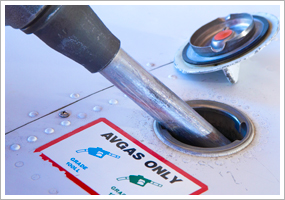| The following stories from the February 12, 2010, edition of AOPA ePilot were provided to AOPA members who expressed an interest in the particular subject areas. Any AOPA member can receive information tailored to their areas of interest by updating their preferences online. TRAINING TIPs‘Usable’ fuelHow much fuel does your trainer carry when “topped off” for flight? How much is actually available for flight planning? Your fuel system awareness will be closely examined on knowledge and practical tests. Consider this private pilot knowledge test sample question:
The Aircraft Weight and Balance Handbook addresses this subject, presenting a chart for an aircraft with a total fuel capacity of 92 gallons: “The maximum fuel is marked on the diagonal line for fuel in terms of gallons and liters. The maximum is 88 gallons of usable fuel. The total capacity is 92 gallons, but 4 gallons are unusable and have already been included in the empty weight of the aircraft.”
What does your trainer’s pilot’s operating handbook say about usable fuel? A 1980 Cessna 152 holds 26 gallons of fuel, but only 24.5 gallons are usable. Remember: That unusable 1.5 gallons is NOT available for flight planning purposes (or reserves).
Sometimes your load prevents topping off. Some manufacturers provide a way for the pilot to know how much fuel there is in a less-than-full tank, explains Mark Twombly’s “What It Looks Like” column in the September 2009 AOPA Flight Training: “For example, a Piper PA-28-161 Warrior III has one fuel tank in each wing, with each tank having a capacity of 24 gallons usable fuel. That's listed in the Limitations section of the POH. But in the Descriptions and Operation section under Fuel System, it says, ‘Each tank is equipped with a filler neck indicator tab to aid in determining fuel remaining when the tanks are not full. Usable capacity to the bottom of the indicator tab is 17 gallons.’”
Never gamble on fuel’s usability, as this excerpt from a fuel exhaustion accident report involving a Cessna 172 makes clear: “During removal of the airplane from the accident scene, about 3 gallons of fuel was found in the fuel tanks, consistent with the amount of unusable fuel in a Cessna 172E.”
So, what answer did you choose to the knowledge test question above? The correct answer is A. TRAINING PRODUCTSTear-proof sectional chartsDoes your sectional chart look like your dog tried to eat it as a snack? Try Sporty’s Pilot Shop’s laminated tear-proof sectional charts. The charts can be folded, but are rugged enough to be used multiple times. They are also great for drawing course lines or circling important data with a grease pen. Each chart is $15.95.
Note: Products listed have not been evaluated by ePilot editors unless otherwise noted. AOPA assumes no responsibility for products or services listed or for claims or actions by manufacturers or vendors. FINAL EXAMQuestion: What are speed brakes, and what is their purpose?
Answer: Speed brakes are aerodynamic devices usually installed on the top of the wing that disrupt the flow of air over the wing. This disruption allows for high rates of descent without drastically increasing the airspeed, which allows the pilot to keep more power applied to keep the engine warm and reduce the chance of shock-cooling the engine. Speed brakes are most commonly found on large jet or turboprop aircraft, but some high-performance piston aircraft have them as well. Got a question for our technical services staff? E-mail [email protected] or call the Pilot Information Center, 800/872-2672. Don’t forget the online archive of “Final Exam” questions and answers, searchable by keyword or topic. |
 Which items are included in the empty weight of an aircraft?
Which items are included in the empty weight of an aircraft?

